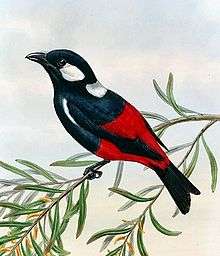Peltops
Peltops is a genus of birds in the family Artamidae. It contains two species that are endemic to the island of New Guinea. The species have also had the common name of shieldbill.
| Peltops | |
|---|---|
 | |
| Lowland peltops Peltops blainvillii | |
| Scientific classification | |
| Kingdom: | Animalia |
| Phylum: | Chordata |
| Class: | Aves |
| Order: | Passeriformes |
| Family: | Artamidae |
| Genus: | Peltops Wagler, 1829 |
| Species | |
Taxonomy
The genus Peltops was introduced by the German zoologist Johann Georg Wagler in 1829.[1] The type species is the lowland peltops.[2] The name is from the Greek pelte meaning small shield and ops meaning face.[3] The genus was once placed with the monarch flycatchers, but molecular and morphometric studies place it closer to the butcherbirds,[4] possibly as a sister taxon to this group.[5] The genus is placed in its own subfamily, Peltopsinae.[6][7]
The genus contains two species:[8]
- Lowland peltops (Peltops blainvillii)
- Mountain peltops (Peltops montanus)
Description
Peltops are smaller than the butcherbirds, and have a less massive but still large bill. The mountain peltops is the larger species, at 20 cm (7.9 in), whereas the lowland peltops is slightly smaller at 18 to 19 cm (7.1–7.5 in). The hooked bill is the same size in both species, making it proportionally larger in the lowland peltops.[9]
Distribution and habitat
Both species occupy rainforest on New Guinea, but are separated by altitude. The lowland peltops ranges across the island from sea level to 600 m (2,000 ft), whereas the mountain peltops ranges from 600 to 3,000 m (2,000–9,800 ft). Within the forest they are particularly common at forest openings and edges, tree falls, river edges, and other disturbed areas including human modified openings like roads and gardens. In undisturbed virgin forest they may use massive trees emerging from and above the canopy.[9]
References
- Wagler, Johann Georg (1829). "Genus Eurylaimus". Isis von Oken (in Latin and German). 22. col. 656.
- Mayr, Ernst; Cottrell, G. William, eds. (1986). Check-list of Birds of the World. Volume 11. Cambridge, Massachusetts: Museum of Comparative Zoology. p. 529.
- Jobling, James A. (1991). A Dictionary of Scientific Bird Names. Oxford: Oxford University Press. p. 176. ISBN 0-19-854634-3.
- Sibley, CG; JE Ahlquist (1984). "The relationships of the Papuan genus Peltops". Emu. 84 (3): 181–183. doi:10.1071/MU9840181.
- Manegold, A (2008). "Composition and phylogenetic affinities of vangas (Vangidae, Oscines, Passeriformes) based on morphological characters". Journal of Zoological Systematics and Evolutionary Research. 46 (3): 267–277. doi:10.1111/j.1439-0469.2008.00458.x.
- del Hoyo, Joseph (ed.). "Taxonomic structure and notes". Handbook of the Birds of the World Alive. Lynx Edicions. Retrieved 5 December 2017.
- Dickinson, E.C.; Christidis, L., eds. (2014). The Howard & Moore Complete Checklist of the Birds of the World, Volume 2: Passerines (4th ed.). Eastbourne, UK: Aves Press. p. 205. ISBN 978-0-9568611-2-2.
- Gill, Frank; Donsker, David, eds. (2017). "Bristlehead, Butcherbirds, Woodswallows & Cuckooshrikes". World Bird List Version 7.3. International Ornithologists' Union. Retrieved 5 December 2017.
- Russell, Eleanor; Rowley, Ian (2009). "Family Cracticidae (Butcherbirds)". In del Hoyo, Josep; Elliott, Andrew; Christie, David (eds.). Handbook of the Birds of the World. Volume 14: Bush-shrikes to Old World Sparrows. Barcelona: Lynx Edicions. pp. 308–342. ISBN 978-84-96553-50-7.